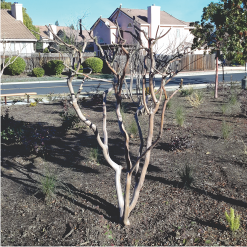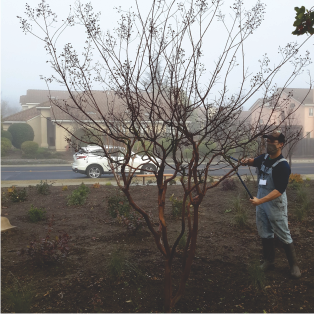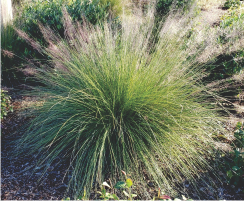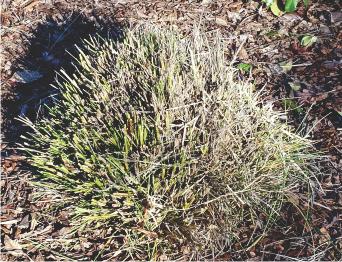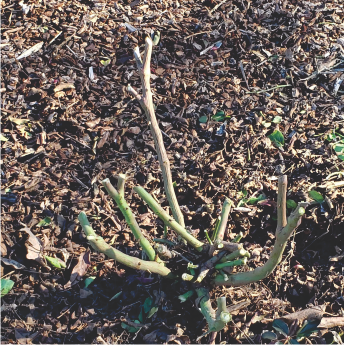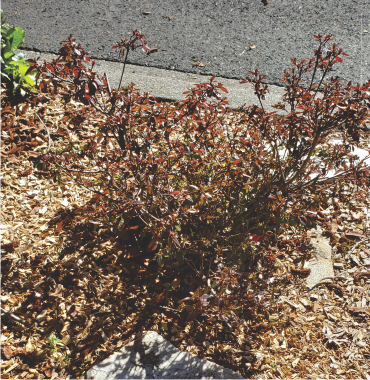By Melody Kendall
Late-winter pruning in the Las Flores Learning Garden's Low-water/low-maintenance garden has recently been completed at the Las Flores Community Center property, home of UC Master Gardeners of Napa County's botanical teaching garden. Currently, it offers four demonstration teaching gardens for the community to observe, learn and enjoy: a Low-water/low-maintenance Garden, a Calif. Native garden, a Pollinator Garden and a Succulent/dry Garden. Each garden offers multiple viewing and educational opportunities.
The gardens are slumbering in this much needed rain, but the weeds are going full steam ahead, thriving regardless of efforts to eradicate them. In the LFLG's Low-water/low-maintenance garden, along with keeping ahead of the weeds, the UC Master Gardeners are doing the late-winter pruning. It is important to learn about the plants in your garden because knowing the optimum time to prune your landscape plants is a must. The Crape Myrtles, the Bush Roses and the Pink Muhly Grass are the three types of plants that we will be pruning in this garden at this time.
We prune the Crape Myrtles in late-winter because these deciduous trees hold onto their leaves well into January. Now that the branches are revealed pruning can begin. Crape myrtle trees can have a single trunk, multi-trunk or a bush style. Ours are trained into small multi trunked trees. We don't want them to get too tall, so first we trim the upper branches down to the start of last year's new growth. Not wanting the tree to look like it has had a flat top hair cut, we follow each branch down to the start of this new growth and cut there. This creates a more organic look rather than an artificial chopped look. With the height brought down we stand back and look at the whole tree to get a better perspective. The objective is to prune the branches back to end up with an upright vase or open upright hand look with the interior of the tree free of any growth. This allows for good air circulation and encourages our tree's multi-branch growth habit. We remove the bulk of the new growth at the originating point, and branches that cross into the interior are removed to their attachment point of the main exterior branches. See the before and after pictures to see the result.
The Pink Muhly Grass plants have been an excellent choice for this low-water/low-maintenance garden. Once established they require little water and actually seem to thrive on neglect. They have green grass-thin foliage for most of the year but in the late fall they explode with color. Shooting up tall stems topped with a ‘fluff' of candy pink, these plants really brighten up a winter garden. Our choice, to wait until late winter to prune these plants, is due to this lovely winter color and, once the color fades, these ‘fluffs' then provide seeds for the birds. Pruning is a relatively simple operation. Each plant is cut to within 6 inches of the ground in a dome-like mound. Hand pruners seem to be the best way to prune these plants. Because of the thinness and combined bulk of the Muhly Grass' leaves, hedge clipper blades become clogged easily and tend to just mash the leaves rather than cutting them. The hand pruner method is hard on the wrist and hands, but we have persevered. Check out the before and after pictures to see the difference. Notice the domed or rounded shape of the pruned mound. Often these plants are pruned with a flat top, but this plant tends to grow out, then up so a rounded shape better suits their growth habit.
Bush roses are known for their fragrant blossoms and mounding growth habit. Though there are some varieties that will climb the variety that we choose for the LFLG the flower carpet ‘Amber Rose'. It is considered a ground cover rose that will only grow to 2 to 3 ft. tall and 3 to 4 ft. wide. These roses are 2 1/2 yrs old, are virtually maintenance free and have filled in their designated area providing wonderfully fragrant orange colored blossoms throughout the summer. In late-winter they are dormant and have lost almost all their leaves. When preparing to prune roses, keep in mind that each of their branches are covered with thorns so, before beginning the pruning process, donning defensive pruning equipment is a must. Wear heavy leather gauntlets that cover both the hands and forearms.
Our goal is to reduce the size of the plants. We are looking for the healthy canes buried in the remaining leaves. First, we remove any of the remaining leaves so that the entire cane structure is revealed.
Now that the plant architecture is revealed, trim back all of last year's growth from the top to the main branching structure. This will bring the height down. Next, look for any shoots that have stopped growing and remove them. Open up the interior of the rose by removing any inward growing branches. Try to cut just above an outward facing bud. That way, the direction of the growth will be out from the interior of the plant. Once you have your plant pruned down and thinned, look for any older pieces of wood that are no longer productive and remove those. Finally, look at your recent cuts. If there are any dark spots in the wood, continue cutting until you get nice white wood. A dark spot indicates that that particular branch is ailing and will not thrive and produce flowers. Visit your bush rose in a couple of weeks and see how it is doing after your pruning efforts. See the photos of before pruning and after pruning.
When the pruning at LFLG's low-water/low-maintenance garden is accomplished, it looks nice and neat and ready for the spring explosion of growth. We chose our plants for the LFLG low-water/low-maintenance garden well. Now that they have established themselves, they need little or no water and the small upkeep requirements are far outweighed by the pleasure they provide of year round color and multiple viewing and education opportunities for the community.
The installation of the Las Flores Learning Garden has created a beautiful botanical oasis on the Las Flores property. The neighborhood and community have already voiced their appreciation of the improvements, and these gardens will only grow and mature as time goes by. The UC Master Gardeners have calendared multiple educational events centered on these new garden areas for 2023. Join us there at the Las Flores Learning Garden to Observe, Learn and Enjoy this wonderful community asset.
Napa Master Gardeners are available to answer garden questions by email: mastergardeners@countyofnapa.org. or phone at 707-253-4143. Volunteers will get back to you after they research answers to your questions.
Visit our website: napamg.ucanr.edu to find answers to all of your horticultural questions.
Photo credits: Mel Kendall
Information links:
UC Master Gardeners of Napa County-Las Flores Learning Garden
https://napamg.ucanr.edu/DemoGarden/
